Affiliate disclosure: This post may contain affiliate links. Please see our Privacy Policy.
Hobbleberry is a species of edible viburnum common as a woodland understory plant. It produces delicious edible berries, if you can beat all the woodland creatures to the prize.
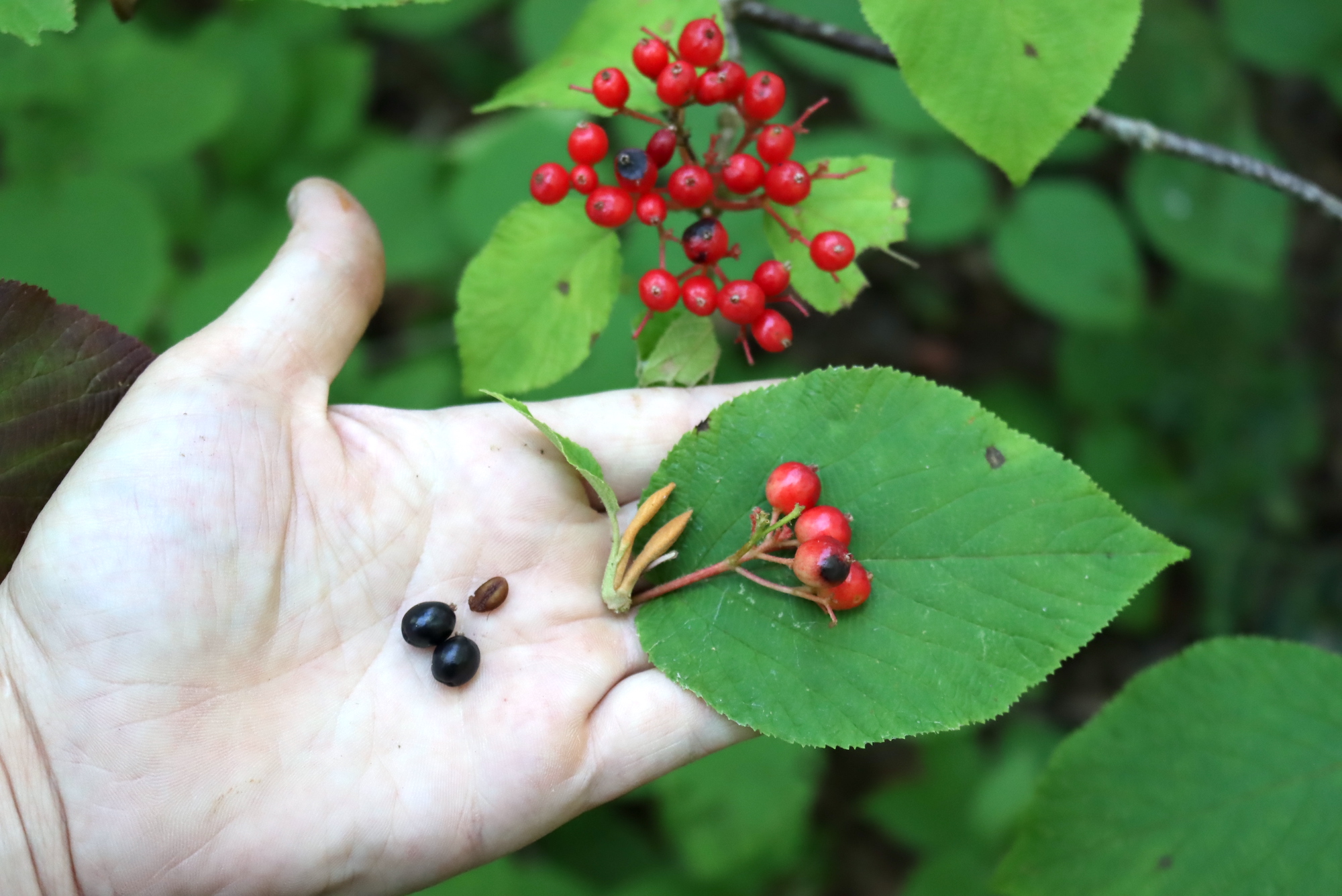
Hobblebush can be a bit hard to spot, though it grows just about everywhere in the understory. It’s so common that foresters label it a “nuisance,” especially around ski resorts, where the low-growing shrubs take over ski trails through the woods if left unchecked. (There’s a reason it’s also called trip toes and tanglefoot, along with hobblebush and witch hobble…)
The plants look a lot like young linden trees (Tilia sp.), at least in their leaves, and you’ll only really notice them when they’re in flower for a short time in the spring. Most of the year, it’s just an inobtrusive bush in the forest, only really identifiable by its very large leaves (and, if you happen to look closely, its unique growing tips).
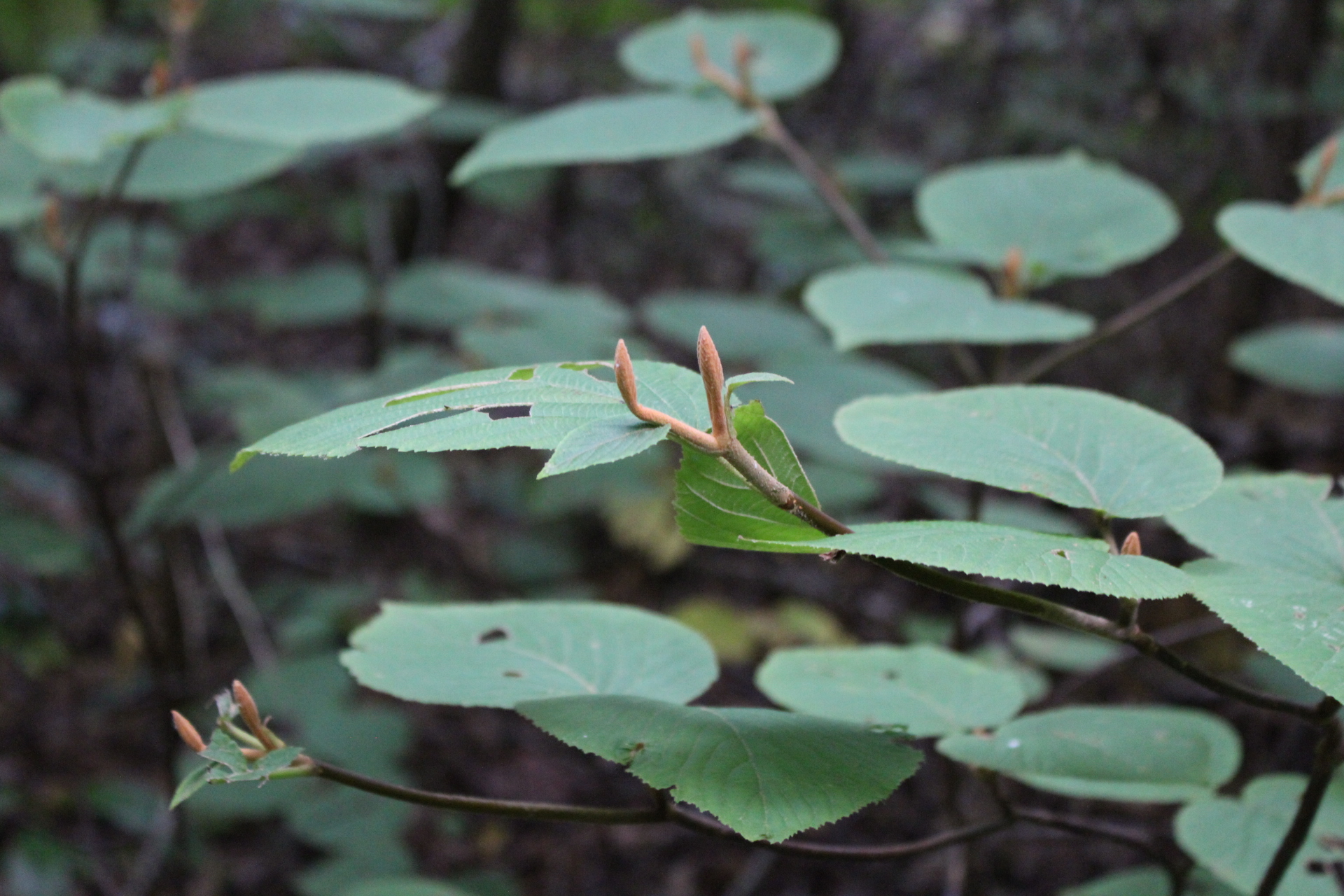
For years, while walking in the woods, I passed right by one of the tastiest understory plants anywhere.
Or, at least, to be fair, the tastiest edible wild fruit that grows in full shade in damp woodland soil…that’s a lot of qualifiers, I know.
Still, hobbleberry is surprisingly good, and by far the best-tasting edible viburnum. It’s better than highbush cranberry, nannyberry, and wild raisin.
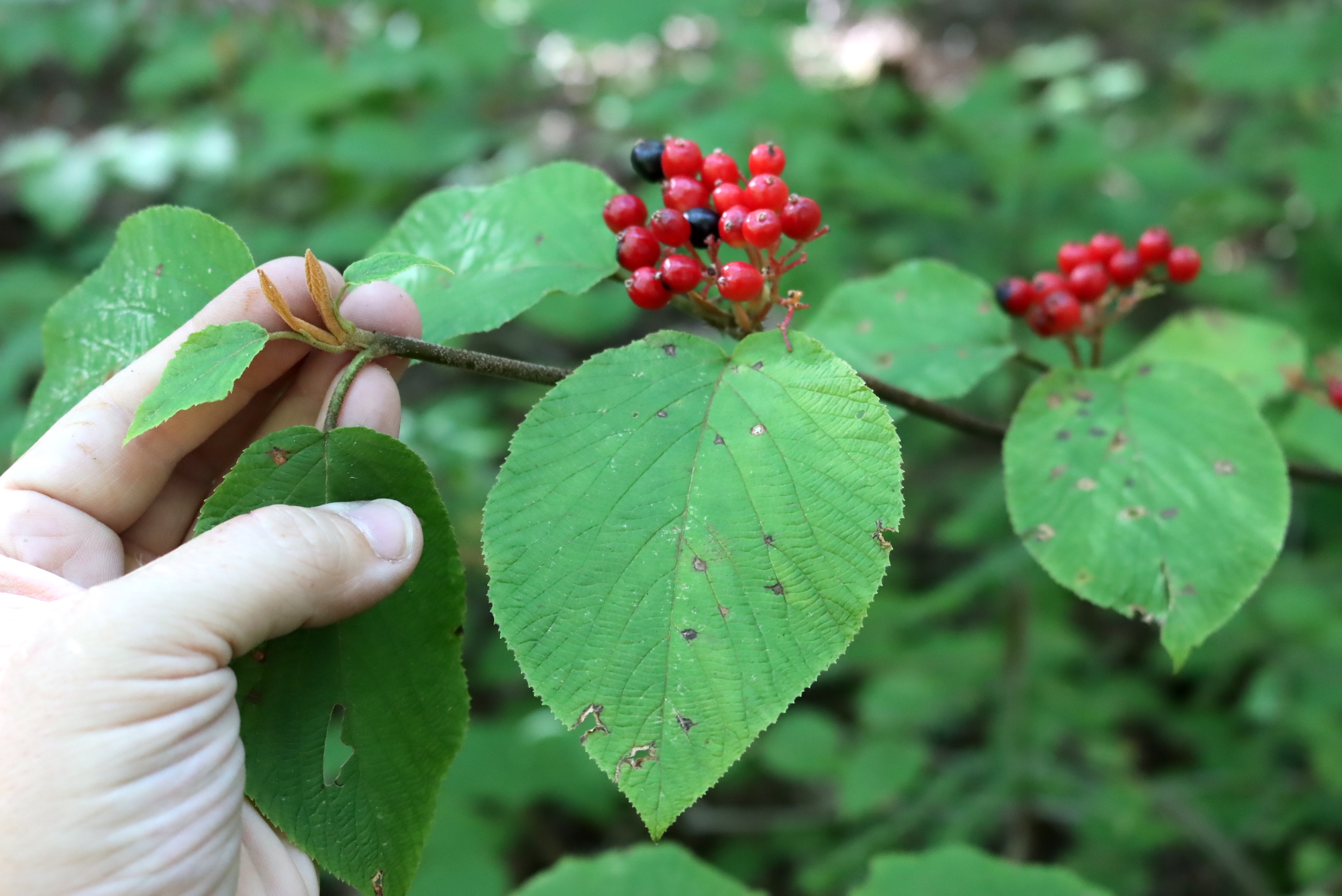
The trick with these, is that few people ever get a chance to taste them, because they ripen earlier than the other viburnums, before the animals start hibernating for winter or fly south for the season. They’re quickly picked off as they ripen, one fruit at a time in a cluster. While you may see the unripe red berries, as soon as the fruit darkens, the animals know it’s tasty time!
Highbush cranberry and Nannyberry, on the other hand, ripen really late, usually after the first snow, and then hang all winter to wait for the animals to disperse them in spring. There’s plenty of opportunity to forage those, even during mid-winter foraging when everything else is gone.
If you want to try hobblebush though, you’ve got to be walking through the woods at just the right time.
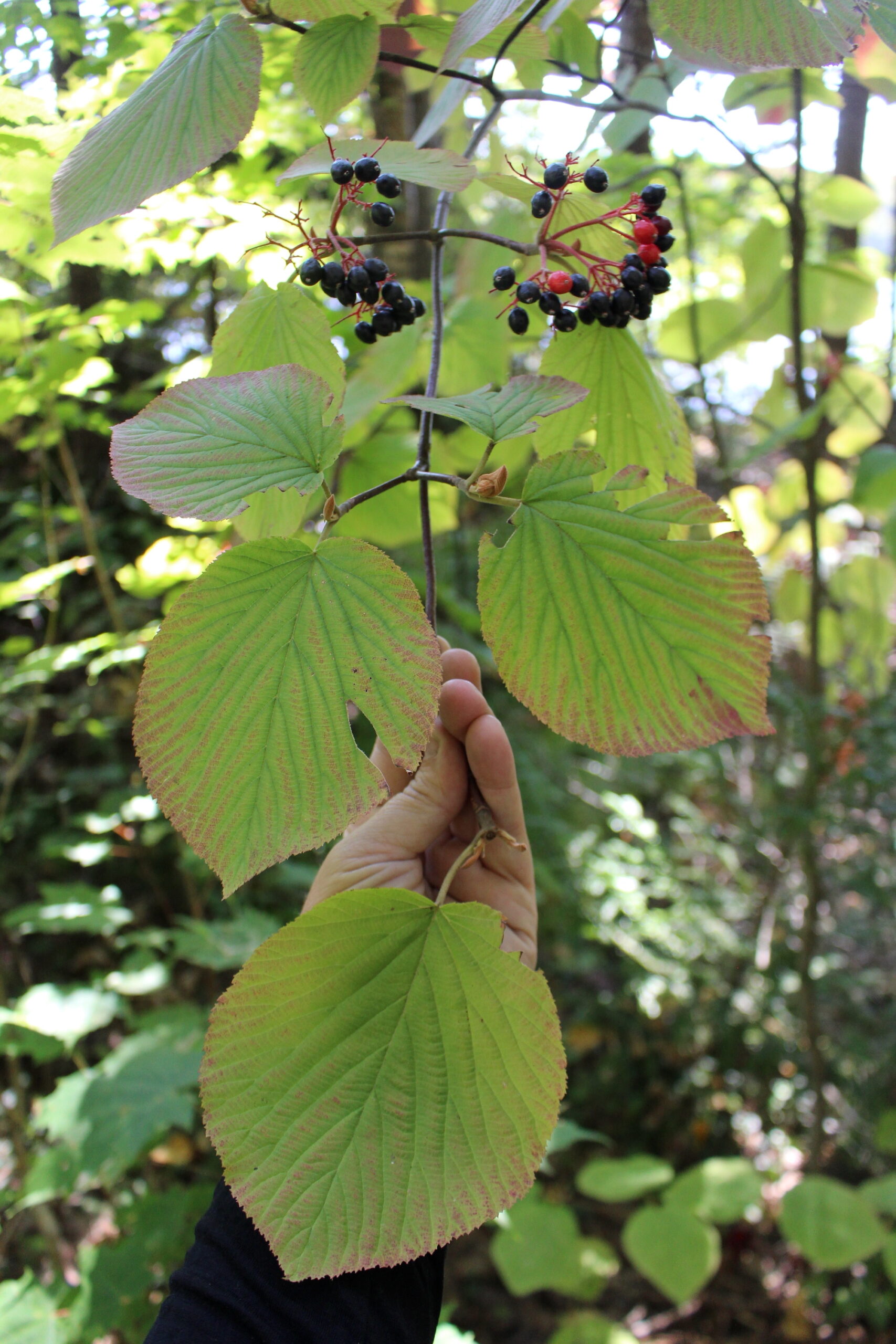
What is Hobblebush?
Hobblebush is a perennial deciduous shrub. One species, Viburnum lantanoides, is native to the eastern United States and Canada.
In some older works, you may also find this same species listed under the Latin name Viburnum alnifolium. Hobblebush also has several other common names, including Witch-Hobble, Trip-Toes, Tangle-Foot, Adirondack Dogwood, Moosewood, Alder-leaved Viburnum, and Hobblebush Viburnum.
A similar species, Viburnum grandifolium, is native to the Himalayan region. This species is widely available as an ornamental garden plant, and there are several cultivars available. Viburnum grandifolium has many common names, including Himalayan Viburnum, Grand Viburnum, Flowering Viburnum, and Cranberry Bush.
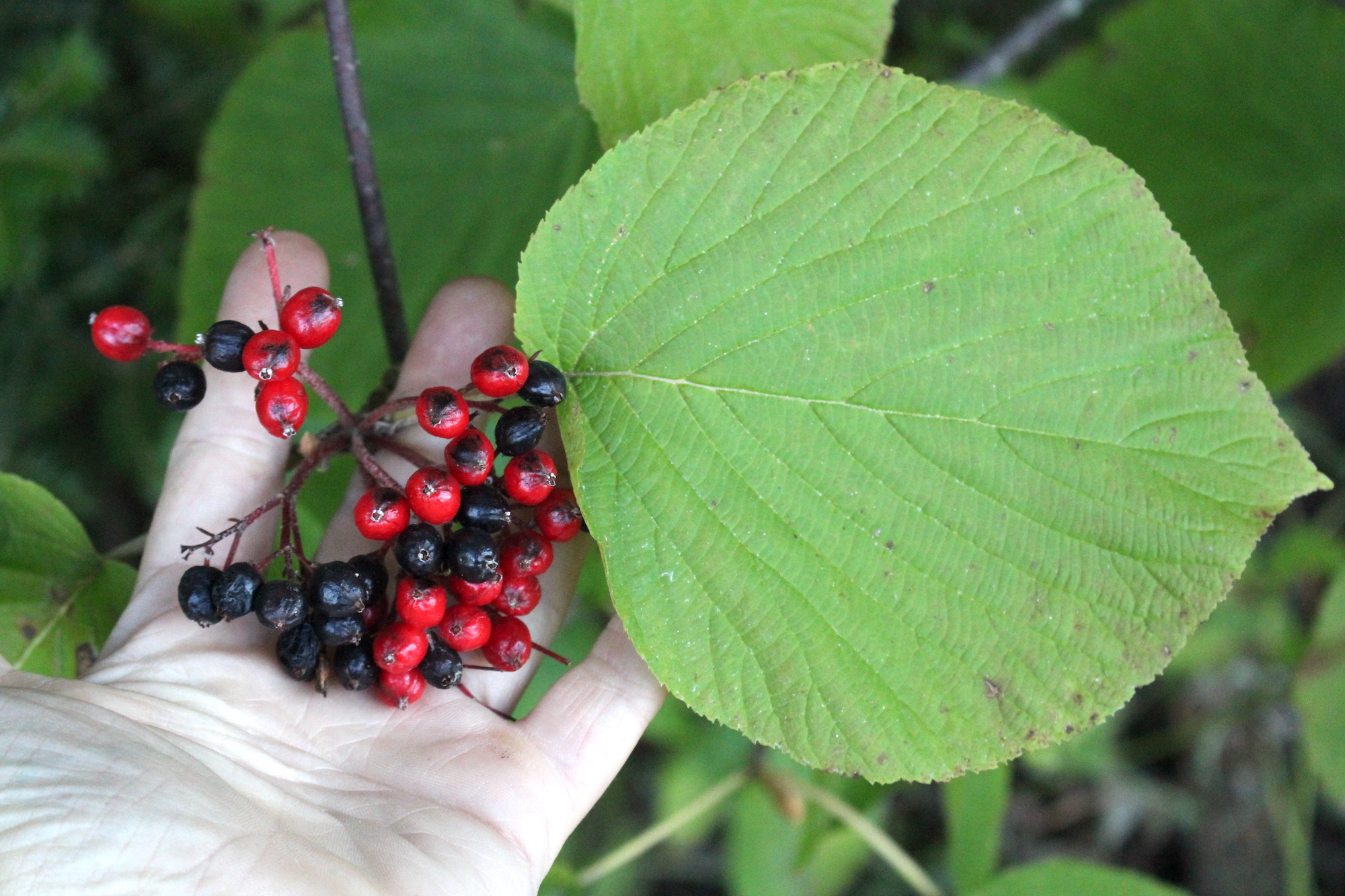
Is Hobblebush Edible?
Yes, Hobblebush has edible berries. You can eat the berries raw or cook them, and many people liken their flavor to raisins or dates. Herbalists will also sometimes use the roots in internal preparations and the leaves in external preparations.
Some foragers report that the berries have the best flavor after a frost. The berries also contain large, hard seeds, which some find unpalatable, so you may want to mill them out when processing larger quantities of berries.
You should also note that Hobblebush (Viburnum lantanoides) may be protected in some areas. It’s currently listed as endangered in Kentucky and New Jersey and as a plant of special concern in Rhode Island.
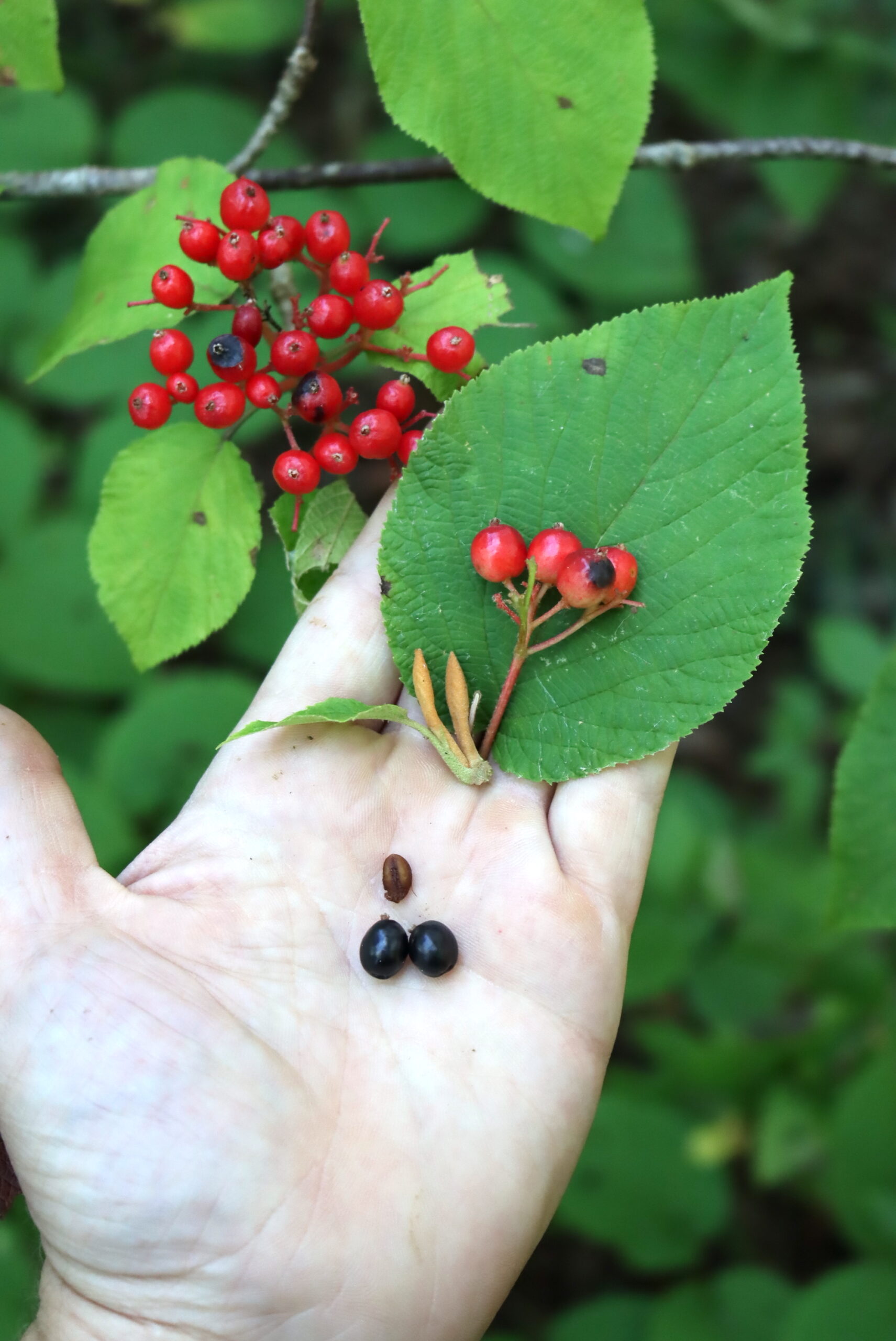
Hobblebush Medicinal Benefits
Historically, Native Americans used Hobblebush (Viburnum lantanoides) for its medicinal properties. The leaves may be analgesic, and the Algonquin reportedly mashed them and rubbed them on the forehead to treat migraines. The Iroquois reportedly made decoctions from the roots for treating blood issues. Different groups may also have used the plant as a fertility aid and for treating chest and breathing problems.
The Himalayan Viburnum (Viburnum grandifolium) also has a long history of use in traditional Asian medicine. Reportedly, it has been used as a mild laxative, a blood purifier, and to help regulate menstrual flow.
Today, species of the genus Viburnum are experiencing renewed interest from modern medical researchers. A 2021 review of the therapeutic potentialities of the genus Viburnum found that over 200 Viburnum species are used in traditional medicine. These species are reported to have antitumor, antimicrobial, antioxidant, antihyperglycemic, anti-inflammatory, and neuroprotective properties and are used to treat a wide range of ailments, including rheumatoid arthritis, kidney cramps, diarrhea, swelling, and coughs.
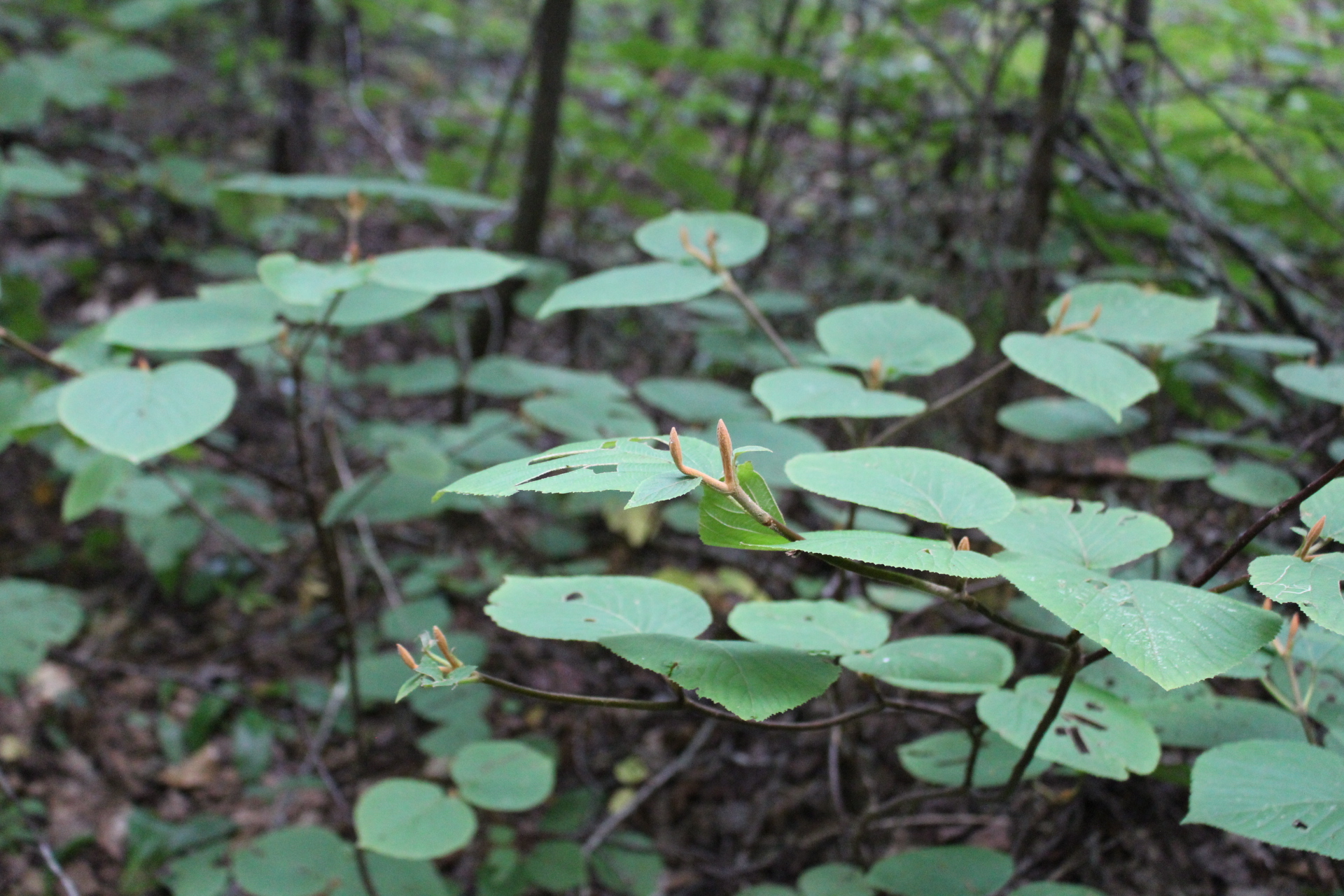
A 2018 study tested Himalayan Viburnum against four strains of bacteria and four strains of fungi and further explored the plant’s compounds and properties. Based on the results, researchers felt that Himalayan Viburnum has enough potential to safely be used as an antimicrobial drug.
Another study found that this same plant, Himalayan Viburnum, may have some potential in treating lung cancer. An extract of Himalayan Viburnum was shown to inhibit lung carcinoma cell viability.
While few studies have focused on the native Hobblebush (Viburnum lantanoides), this renewed interest in Viburnum will hopefully provide further insights into its medicinal value.
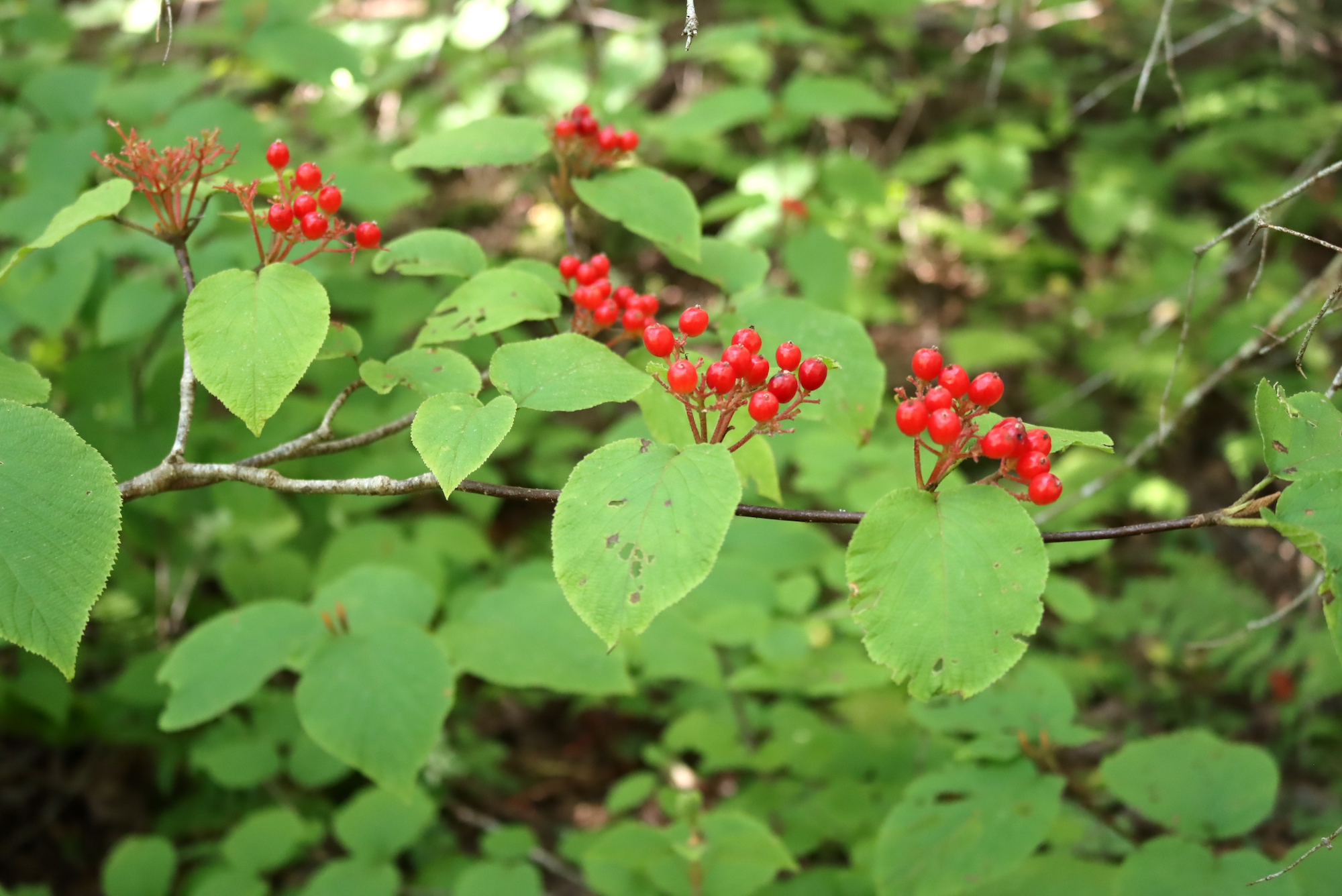
Where to Find Hobblebush
Hobblebush (Viburnum lantanoides) grows in eastern Canada down through the eastern United States as far south as Georgia. Himalayan Viburnum (Viburnum grandifolium) is native to the Himalayan region, including Tibet, Nepal, Pakistan, and parts of India.
Hobblebush is an understory species that tolerates heavy shade and will grow in coniferous, mixed, and hardwood forests. It will grow in various soil types but requires cool habitats with plenty of moisture. You’ll often spot it in moist woodlands, mountainsides, and along the banks of streams and swamps.
Like Hobblebush, Himalayan Viburnum prefers moist soils. Deep, loamy soil is ideal. It typically grows in open woodland or along woodland edges where it will receive dappled shade. You may spot cultivars of this plant growing in people’s gardens or along pathways.
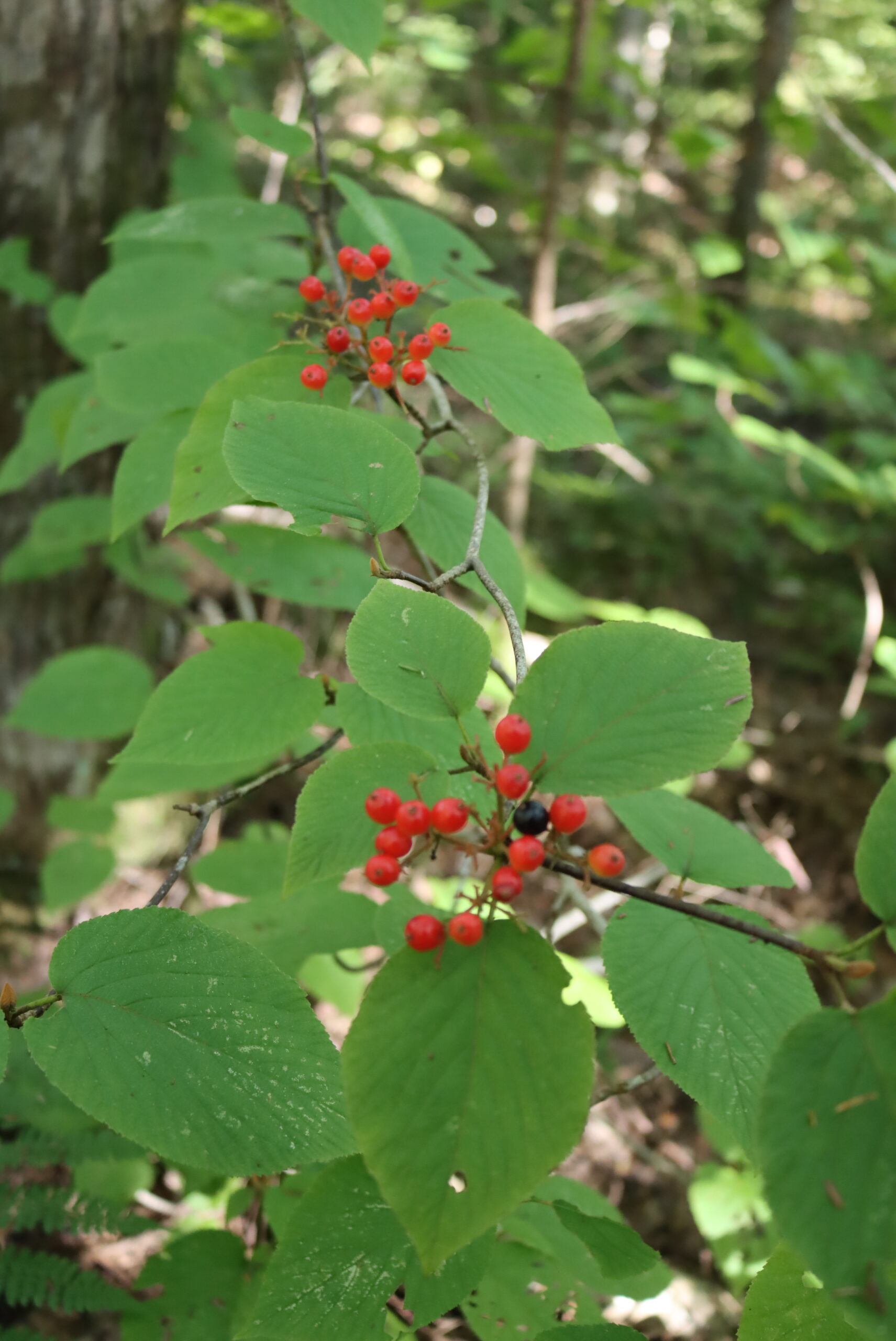
When to Find Hobblebush
As a perennial, Hobblebush can be found year-round, but it loses its leaves in fall like other deciduous trees and shrubs. Before the leaves drop, they turn shades of bronze-red to purple. In northern regions, this typically happens in mid-September, but they may not reach peak color until October in more southerly areas. Himalayan Viburnum is similar and often grown for its attractive foliage.
Hobblebush typically flowers in May, though in northern areas or in harsh springs, you may not see them until late May or early June. The fruit that appears after flowering typically matures in late summer or early autumn from August through September, depending on your climate.
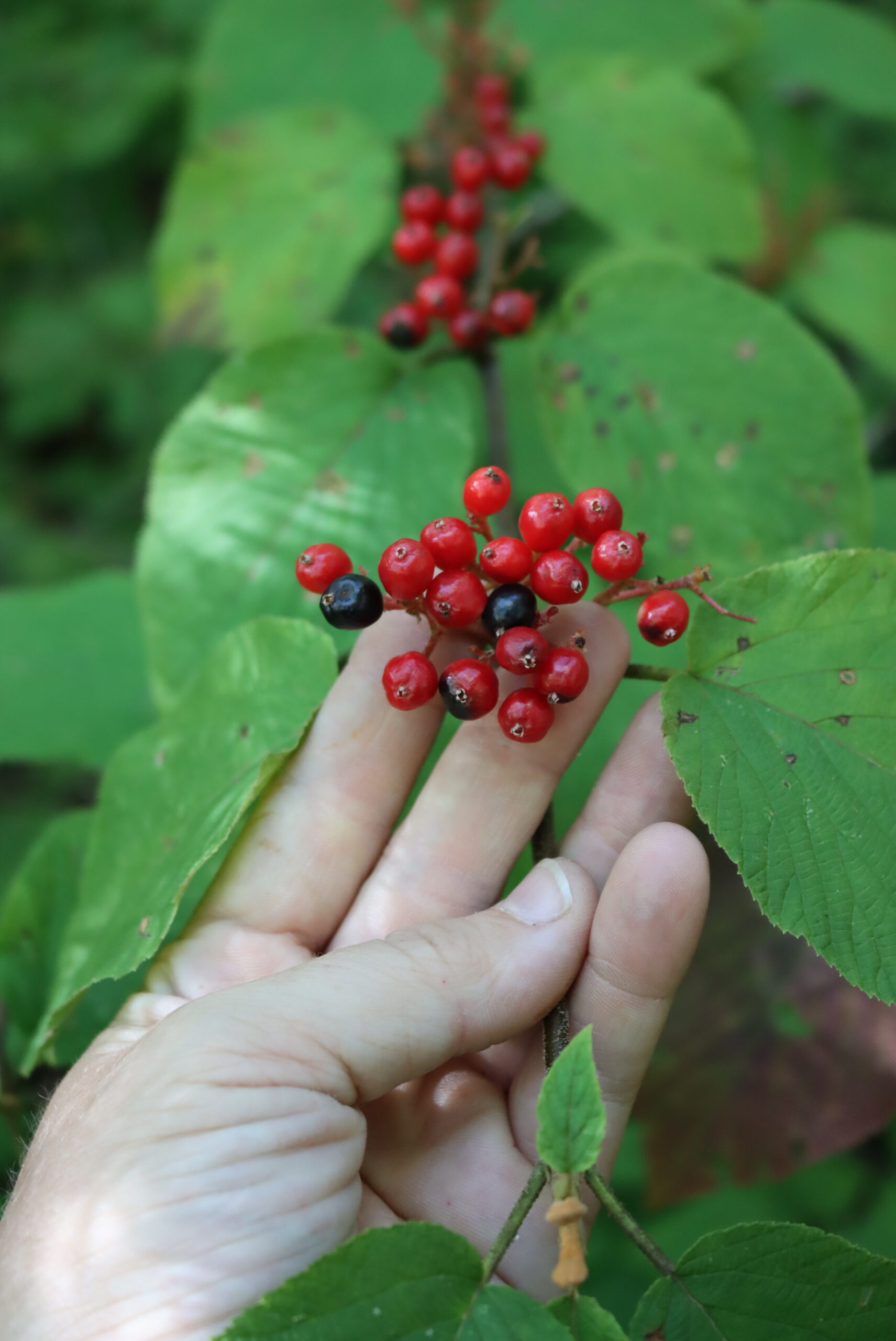
Similarly, most Himalayan Viburnum cultivars will flower in early spring or summer, usually between May and June. The fruit ripens from green to pink and red to a final mature dark blue-black in late summer or early autumn.
The leaves turn a vibrant shade of purple during foliage season, and that’s one great time to spot them.
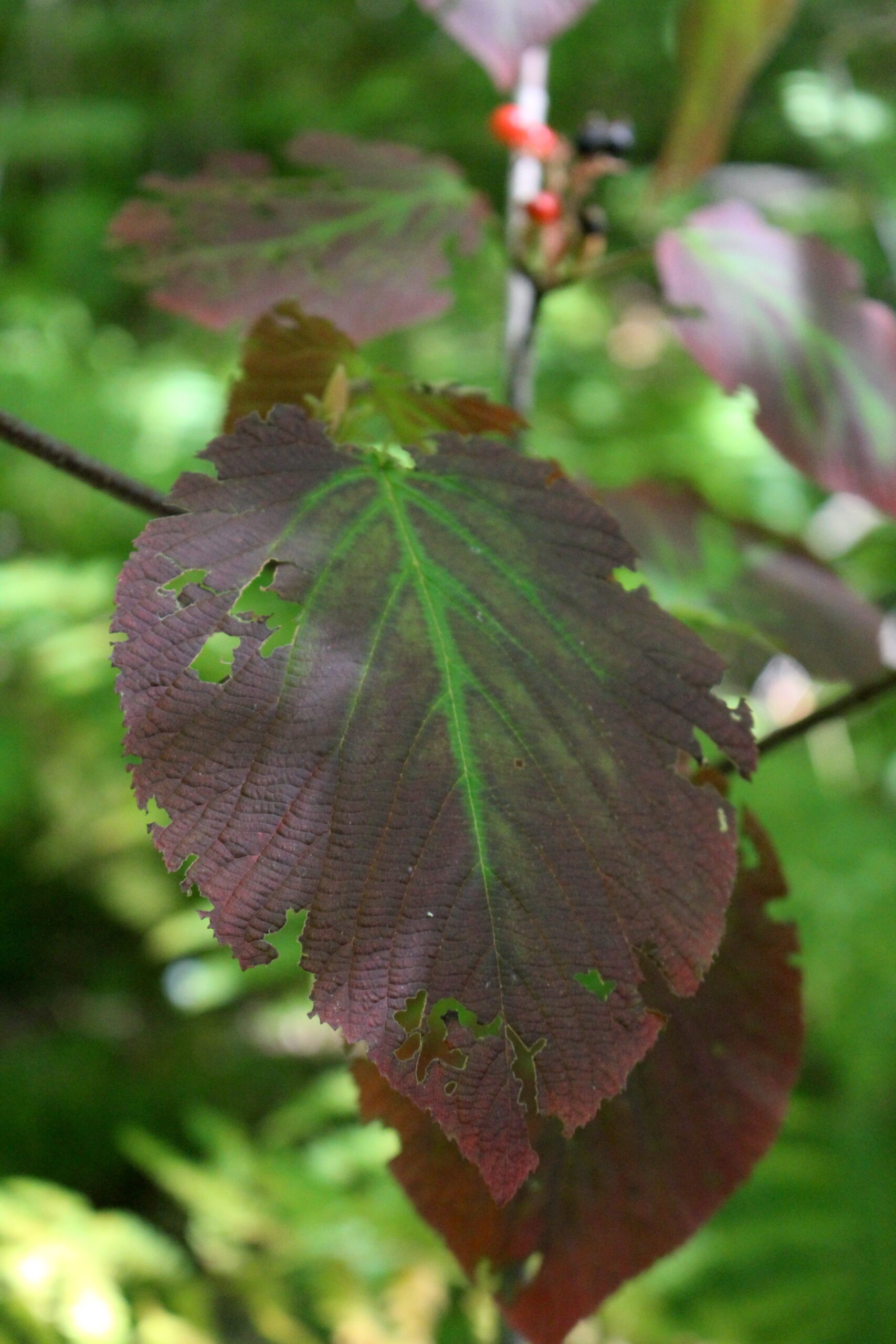
Identifying Hobblebush
Hobblebush and the related Himalayan Viburnum are straggling deciduous shrubs usually about three to six feet tall and 4 to 12 feet wide. Occasionally, they reach heights of 10 feet.
Hobblebush is named for its branches’ habitat of bending over and taking root, creating hoops that “hobble” or trip hikers, foragers, and other woodland wanderers. In part due to its ability to spread vegetatively, Hobblebush often forms dense patches.
Both species are easiest to spot in flower or fruit. In Hobblebush, the flat-topped flower clusters and colorful berries also protrude above the leaves, making them highly noticeable. The same is true for Himalayan Viburnum fruit, and their flower clusters are even more pronounced as they appear before the plant leaves out.
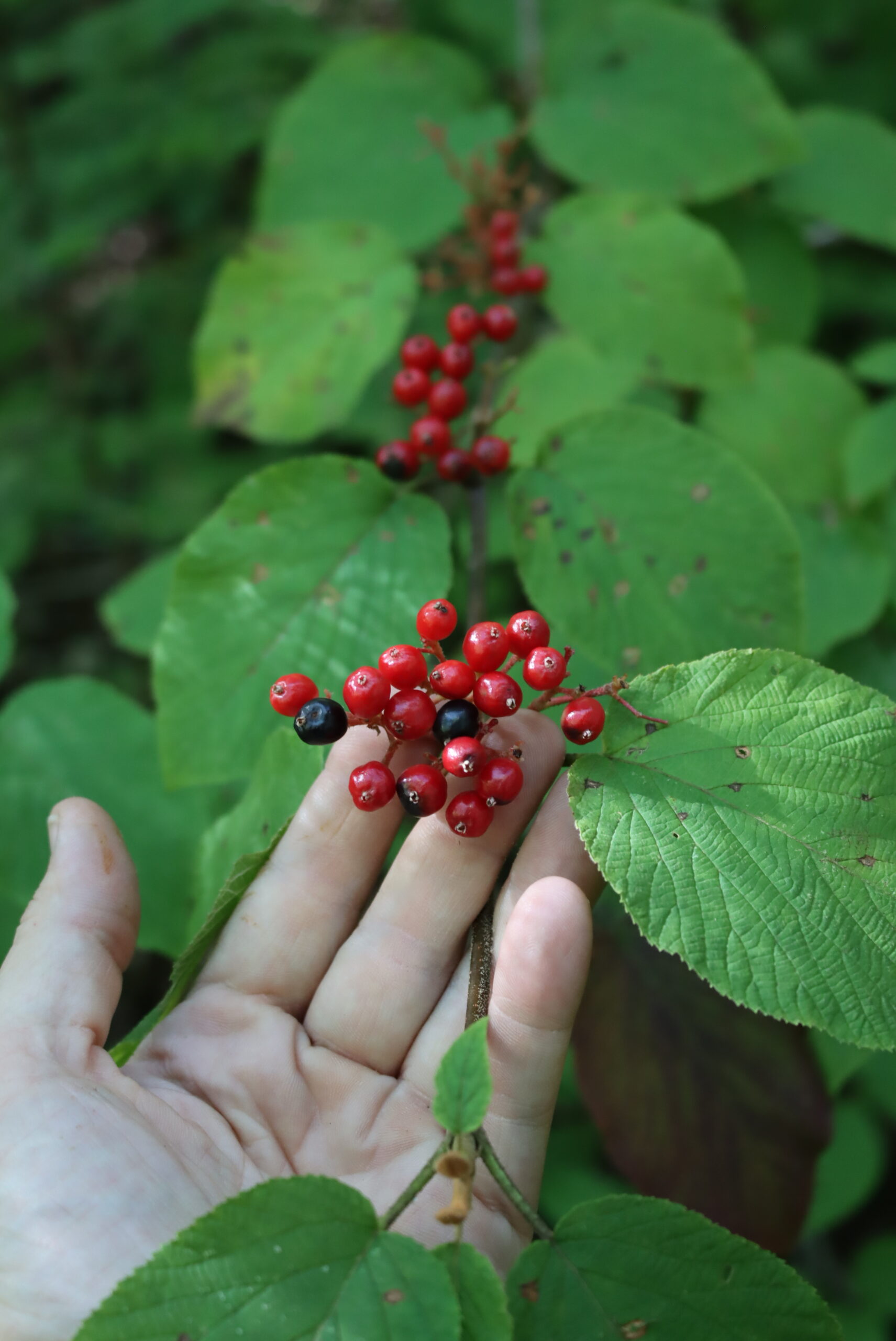
Hobblebush Leaves
Hobblebush forms large, simple, opposite leaves with two leaves per node. Each leaf is about 4 to 8 inches long, finely toothed, and heart-shaped at the base with rounded lobes. They have prominent veins and rust-colored hairs on their undersides. The leaves are green in the summer but change to shades of bronze-red or purple in autumn.
The leaves of Himalayan Viburnum are similar in appearance, except they tend to be more narrowly oval and tapered at both ends. They’re typically 3 to 4 inches long and about half as wide. The leaves are usually downy beneath and form on purplish stems ¾ to 1 inch long.
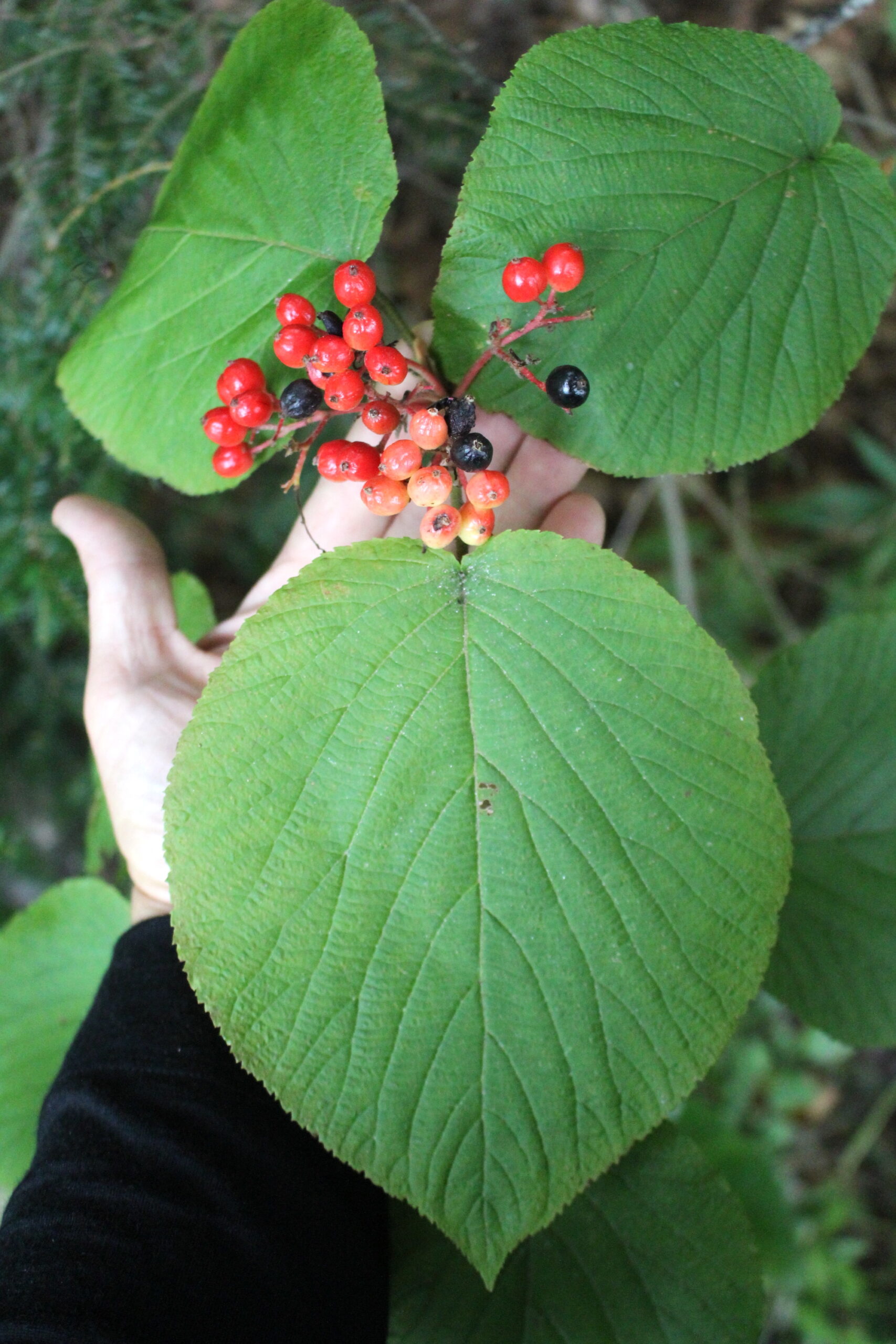
Hobblebush Stems
The stems of Hobblebush and Himayalan Viburnum may reach up to 10 feet tall, though they’re usually closer to three to six feet. Both are generally described as straggly and don’t have a distinct form.
Older stems typically become grayish or dark brown and have rougher ridged or plated bark. New, young stems tend to be smoother and may be shades of green, red, brown, or purple.
The growing tips are distinctive and upturned yellow leaf buds are one of the easiest ways to identify this plant.
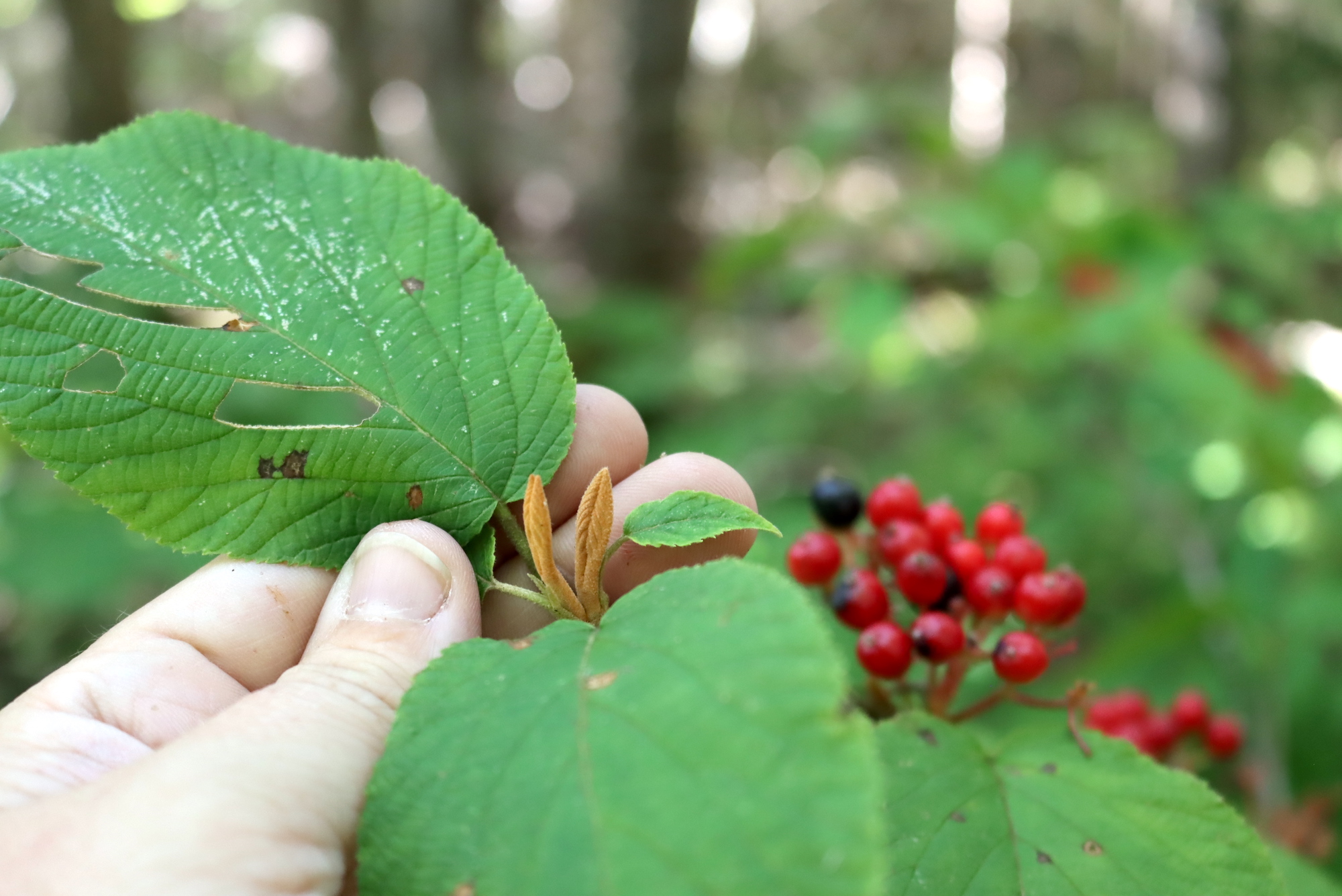
Hobblebush stems reproduce vegetatively and topple over to touch the ground and root. They form hoops that trip passers by and give the plant its common name. This feature posed a more serious threat in the past as horses carrying riders through the woods or working on logging teams would be “hobbled” by them.
The wood is strong and flexible, giving the plant another common name, Witch Hobblebush. The “witch” comes from the Middle English word “withy,” which means a strong, flexible switch-like branch.
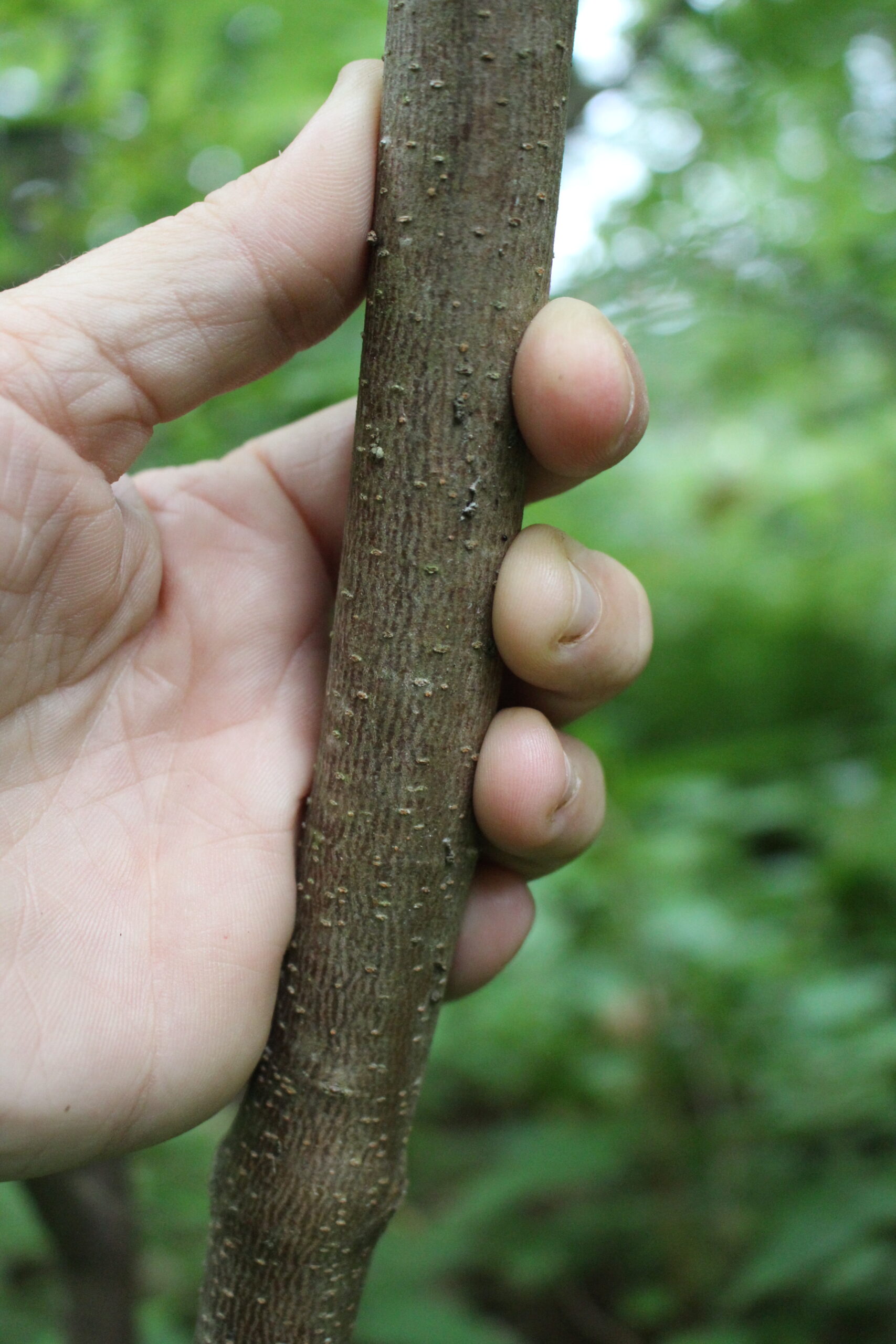
Hobblebush Flowers
Hobblebush features flat-topped clusters of white flowers about 2 to 6 inches wide that appear in May or June. The cluster features large, showier, white flowers on the outer edge, which are infertile. The center flowers are much smaller, greenish-white, and fertile.
In the wild, Himalayan Virburnum usually has clusters of tubular or trumpet-like white or pink flowers, each about ½ inch long. Many cultivars have spherical clusters of white flowers.
Hobblebush Fruit
Hobblebush berries form in clusters 5 to 6 inches wide, which tend to stick up above the leaves. The individual berries are oval and about ⅓ inch long. They ripen from green to pink or red to a final mature, dark, blue-black. Himalayan Viburnum fruits are similar, except they tend to be slightly larger, ½ to ¾ inch long.
The fruit tends to ripen just one or two at a time, unlike other fruits that ripen by the whole cluster.
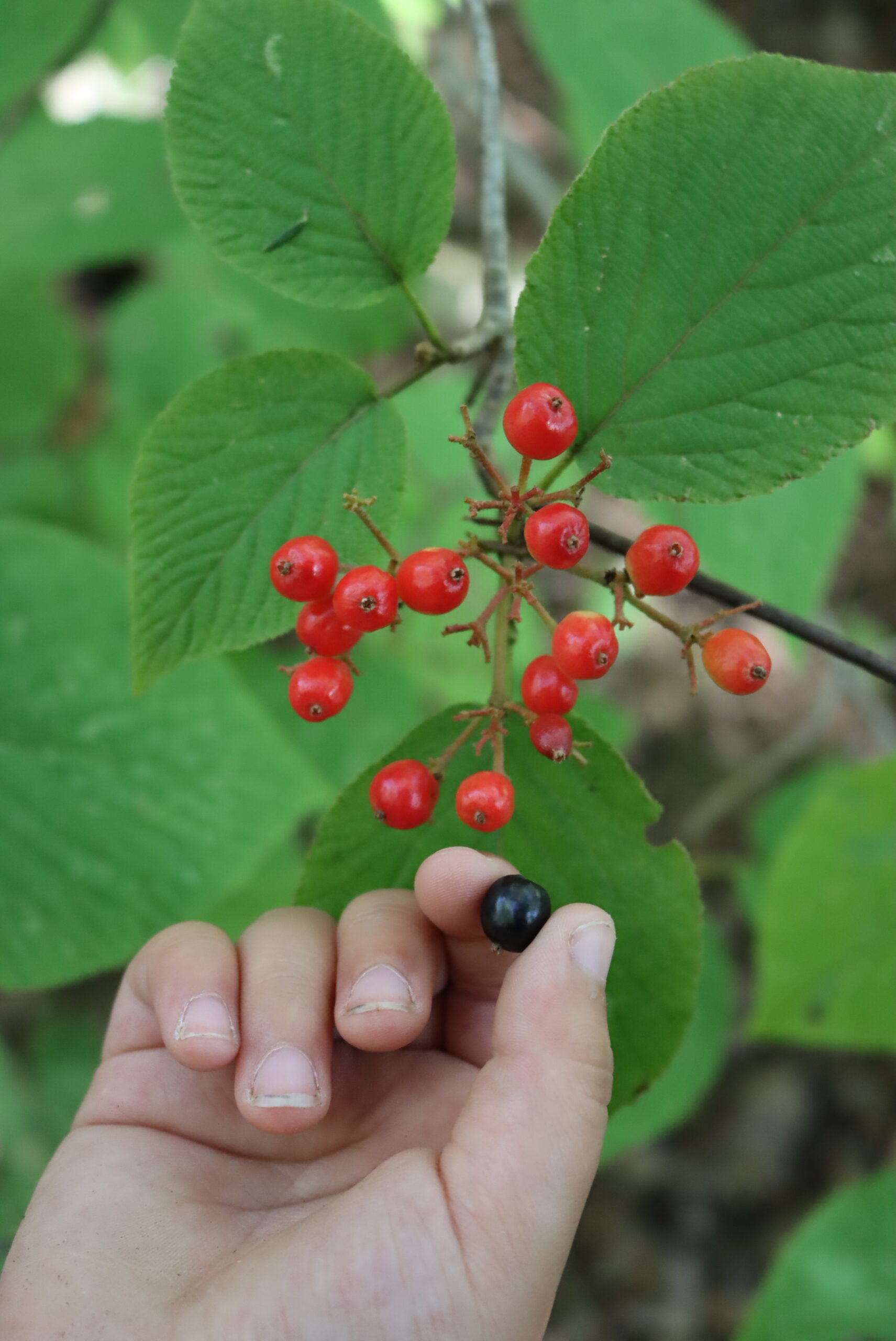
Hobblebush Seeds
The seeds inside hobblebush fruits are large, flat ovals that fill most of the inside of the fruit. The fruit itself is really just a bit of sweet flesh around these large seeds.
They’re about the size of sunflower seeds, and generally not considered edible. If you’re working with Hobblebush for recipes, you’ll need to put them through a food strainer to remove the seeds…or just eat them in the field and spit the seeds out as you go.

Hobblebush Look-Alikes
Hobblebush and Himalayan Viburnum are sometimes mistaken for Hydrangeas (Hydrangea spp.), particularly Lacecap cultivars. Thankfully, you can distinguish them in the following ways:
- Hydrangeas bloom later in the summer and have a very long bloom period. They sometimes bloom for up to two months and may bloom once in summer and again in fall.
- Hydrangea flowers may be a range of colors, including pink, blue, purple, white, and red.
- Hydrangeas produce tiny, many-seeded capsules rather than fleshy berries.
- Hydrangeas tend to have a less straggly appearance and don’t reproduce vegetatively.
Hobblebush may also be mistaken for Striped Maple or Moose Maple (Acer pensylvanicum). In northern areas, loggers once called Hobblebush “she-moosewood,” believing it was the female form of Moose Maple. However, they are not related at all, and they differ in a few easy-to-spot ways:
- Striped Maple is a tree that reaches 16 to 33 feet tall.
- The young bark of Striped Maple is striped green and white.
- The leaves are broad and soft and have three shallow, forward-pointing lobes.
- Striped Maple produces winged seeds rather than berries.
Hobblebush and Himalayan Viburnum can also be confused with Nannyberry (Viburnum lentago), another closely related plant with edible berries. However, it too differs in a few noticeable ways:
- Nannyberry may reach 30 feet tall.
- Nannyberry has oval leaves with rounded bases that grow 2 to 4 inches long and ¾ to 2 inches wide.
- Nannyberry produced rounded clusters of equally sized bell to saucer-shaped white flowers. The clusters are about 2 to 3 ½ inches across.
- Nannyberry produces clusters of oval ⅓ to ½ long fruits that ripen to blue-black in the fall.
Lastly, at a casual glance, the leaves of hobblebush look a lot like native basswood or linden trees (Tilia sp.). This is only a problem when linden trees are young, and the only similar part is the leaves. Linden trees do not have red or black fruits, and their flower structure is very different. They don’t even flower until they’re full-sized trees anyway.

Ways to Use Hobblebush
The most common way to use Hobblebush is to eat the berries. You can eat them raw right off the bush; just make sure they’re fully ripe and a nice blue-black color. Unripe berries may be bitter.
If you’re lucky enough to have a good patch of Hobblebush, you can preserve the berries as jam, jelly, or fruit butter. Milling out the seeds and making jelly is a wonderful way to use Hobblebush berries if you find the seeds unpalatable.
Once you’ve processed the berries and milled out the seeds, you can also add them to other recipes. They’re a great addition to fruit leather, pie, and other baked goods.
Those folks interested in fermenting could also use them to create wine or soak them in their favorite alcohol for a sweet, hobblebush liqueur.
Hobblebush isn’t widely used by modern herbalists. The leaves may have some analgesic properties and can be used externally. You should start with a small amount to test for allergic reactions. Additionally, the roots were used in decoctions in traditional medicine.
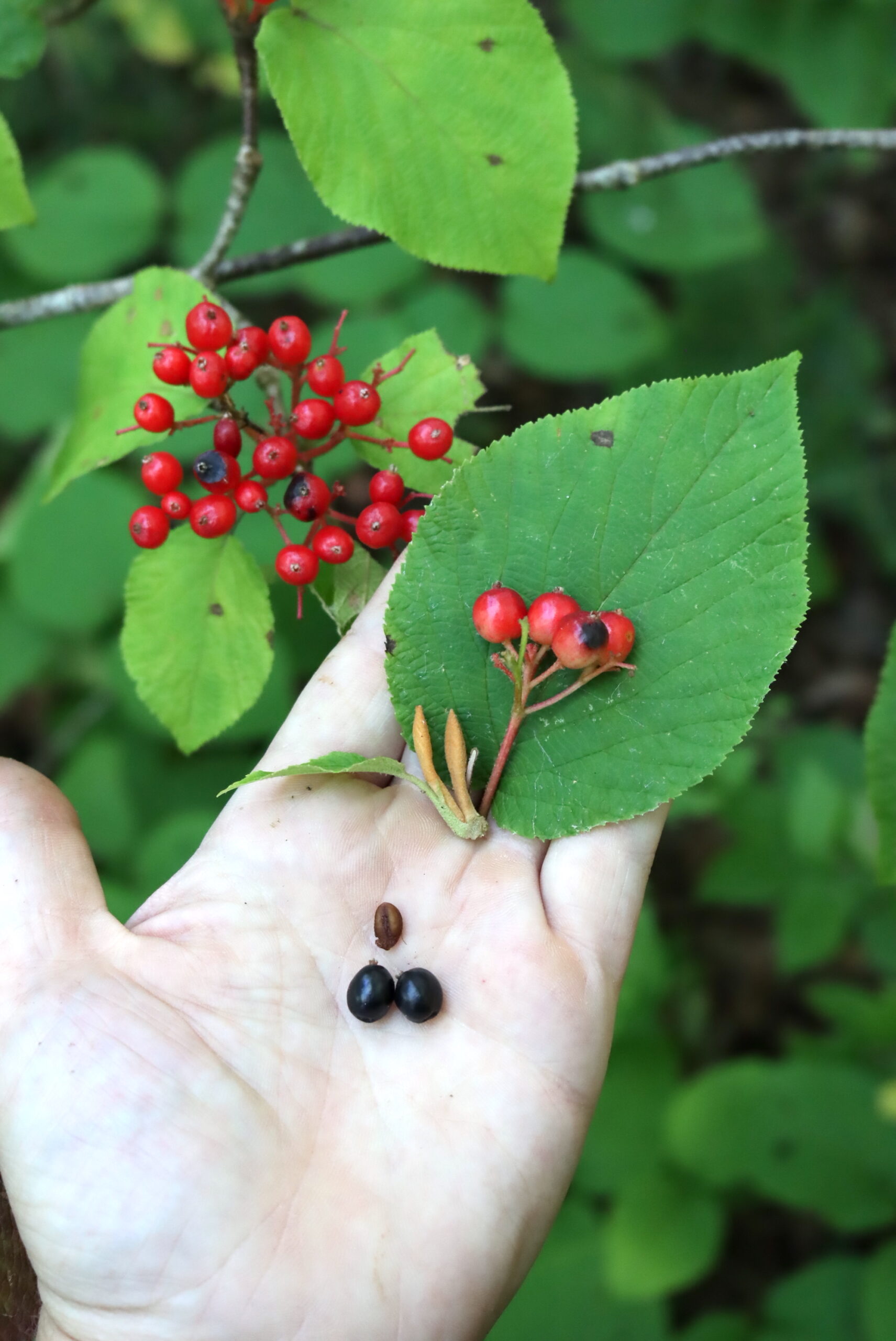
Hobblebush Recipes
Looking to preserve your berries? Try these recipes for Hobblebush Jam, Hobblebush Jelly, or Hobblebush and Apple Jelly from Ernestina Parziale.
This recipe for Maple Nannyberry Butter from the Forager Chef would also work well with Hobblebush Berries and looks delicious.
Fruit Foraging Guides
Looking for more tasty edible wild fruit?
- Foraging Barberry
- Foraging Rose Hips
- Foraging Rowanberry
- Foraging Autumn Olive
- Foraging Partridgeberry
Foraging Guides
Looking for more edible wild plants to forage?
- Foraging Black Walnuts (Juglans nigra)
- Foraging Fiddlehead Ferns
- Foraging Ramps (Wild Leeks)
- Foraging Wild Asparagus
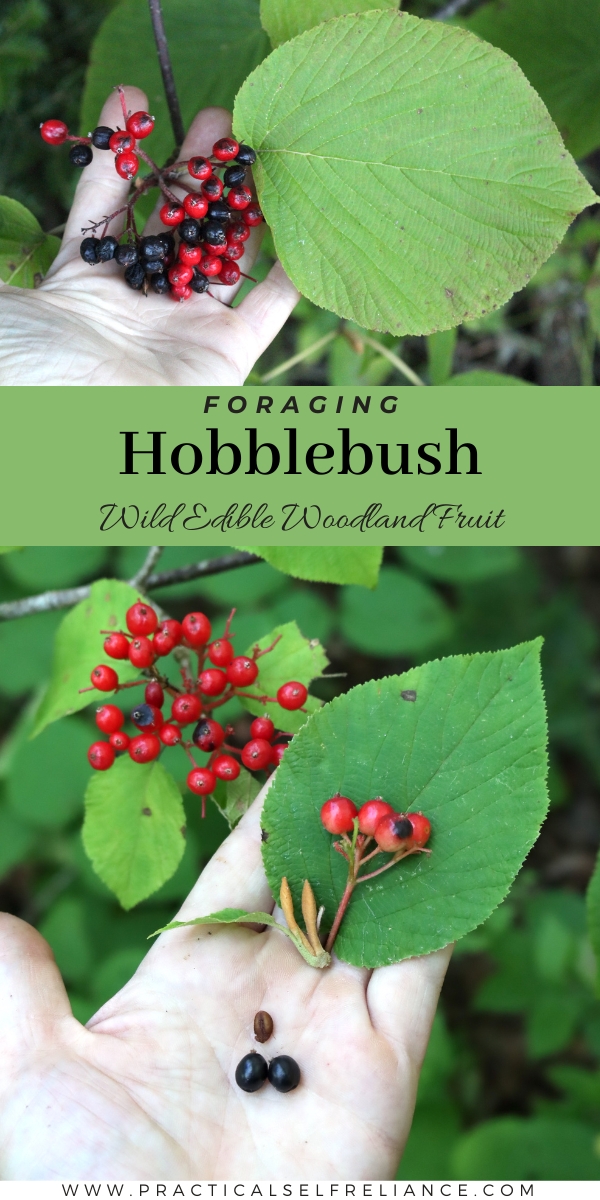



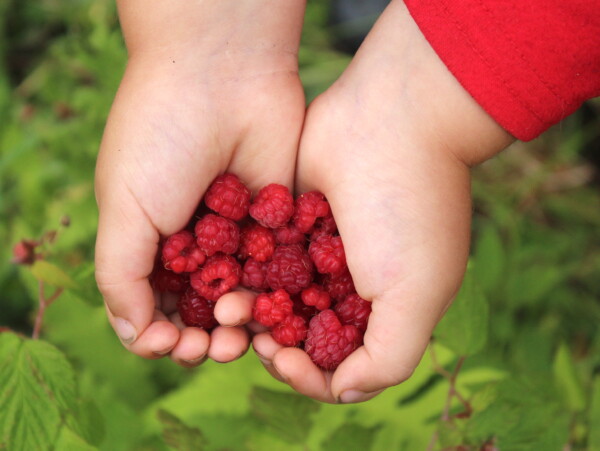










Wow! This can be one particular of the most helpful blogs We’ve ever arrive across on this subject. Actually Fantastic. I’m also a specialist in this topic therefore I can understand your hard work.
Thanks so much! I’m so glad it was helpful to you.